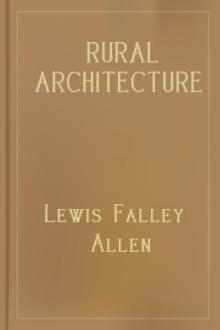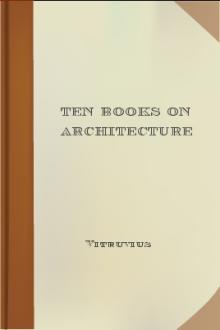Rural Architecture, Lewis Falley Allen [8 ebook reader .txt] 📗

- Author: Lewis Falley Allen
- Performer: -
Book online «Rural Architecture, Lewis Falley Allen [8 ebook reader .txt] 📗». Author Lewis Falley Allen
The other plan of arranging the hives alluded to, is suspending them between the strips before described, by means of cleats secured on to the front and rear sides of the hive, say two-thirds the way up from the bottom. In such case, the strips running lengthwise the house must be brought near enough together to receive the hives as hung by the cleats, and the bottom boards, or forms, must be much smaller than those already described, and hung with wire hooks and staples to the sides, with a button on the rear, to close up, or let them down a sufficient distance to admit the air to pass freely across them, and up into the hive—Weeks' plan, in fact, for which he has a patent, together with some other fancied improvements, such as chambers to receive the boxes for the deposit of surplus honey. This, by the way, is the best "patent" we have seen; and Mr. Weeks having written an ingenious and excellent treatise on the treatment of the bee, we freely recommend his book to the attention of every apiarian who wishes to succeed in their management. As a rule, we have no confidence in patent hives. We have seen scores of them, of different kinds, have tried several of great pretension to sundry virtues—such as excluding moths, and other marvelous benefits—and, after becoming the victim of bee empirics to the tune of many a dollar, have thrown aside the gimcracks, and taken again to a common-sense method of keeping our bees, as here described. The bees themselves, we feel bound to say, seem to hold these patent-right habitations in quite as sovereign contempt as ourself, reluctantly going into them, and getting out of them at the first safe opportunity. But, as a treatise on bee-keeping is not a part of this present work, we must, for further information, commend the inquirer on that subject to some of the valuable treatises extant, on so prolific a subject, among which we name those of Bevan, Weeks, and Miner.
The bee-house should be thoroughly whitewashed inside every spring, and kept clean of cobwebs, wasp's nests, and vermin; and it may be painted outside, a soft and agreeable color, in keeping with the other buildings of the farm. Its premises should be clean, and sweet. The grass around should be kept mowed close. Low trees, or shrubbery, should stand within a few yards of it, that the new swarms may light upon them when coming out, and not, for want of such settling places, be liable to loss from flying away. It should, also, be within sight and hearing, and at no great distance from a continually-frequented room in the dwelling—perhaps the kitchen, if convenient, that, in their swarming season, they may be secured as they leave the parent hive. The apiary is a beautiful object, with its busy tenantry; and to the invalid, or one who loves to look upon God's tiny creatures, it may while away many an agreeable hour, in watching their labors—thus adding pleasure to profit.
The cost of a bee-house, on the plan given, may be from ten to fifty dollars, according to the price of material, and the amount of labor expended upon it. It should not be an expensive structure, in any event, as its purpose does not warrant it. If a gimcrack affair be wanted, for the purposes of ornament, or expense, any sum of money may be squandered upon it which the fancy of its builder may choose to spare.

ICE-HOUSE.

GROUND PLAN.
AN ICE-HOUSE.Among the useful and convenient appendages to the farm and country family establishment, is the ice-house. Different from the general opinion which prevailed in our country before ice became so important an article of commerce, and of home consumption, the building which contains it should stand above-ground, instead of below it. And the plainer and more simple it can be constructed, the better.
The position of the ice-house may be that which is most convenient to the dwelling, or to the wants of those who use it. If it can be placed beneath the shade of trees, it will so far be relieved from the influence of the sun; but it should be so constructed that sunshine will not affect the ice within it, even if it stand unsheltered; and as it has, by the ice-merchants of our eastern cities, who put up large quantities for exportation abroad, and others in the interior, who furnish ice in quantity for home consumption, been proved to be altogether the better plan to build the ice-house entirely above ground, we shall present no other mode of construction than this. It may be added, that five years' experience with one of our own building, has confirmed our opinion of the superiority of this over any other plan which may be adopted.
The design here presented is of the most economical kind, yet sufficiently ornamental to make it an agreeable appendage to any family establishment. The size may be 12 feet square—less than that would be too small for keeping ice well—and from that up to any required extent. The idea here given is simply the principle of construction. The posts should be full eight feet high above the ground, to where the plate of the roof is attached, and built thus:
Mark out your ground the size you require for the house; then, commencing at one corner, dig, opposite each other, a double set of holes, one foot deep, and two and a half feet apart, on each side of the intended building, say three feet equidistant, so that when the posts stand up they will present a double set, one and a half feet apart. Then set in your posts, which should be of oak, chestnut, or some lasting wood, and pack the earth firmly around them. If the posts are sawed, they may be 4×6 inches in size, set edgeways toward each other. If not sawed, they may be round sticks cut from the woods, or split from the body of a tree, quartered—but sizable, so as to appear decent—and the insides facing each other as they stand up, lined to a surface to receive the planking. Of course, when the posts are set in the ground, they are to show a square form, or skeleton of what the building is to be when completed. When this is done, square off the top of each post to a level, all round; then frame, or spike on to each line of posts a plate, say six inches wide, and four to six inches deep, and stay the two plates together strongly, so as to form a double frame. Now, plank, or board up closely the inside of each line of posts, that the space between them shall be a fair surface. Cut out, or leave out a space for a door in the center of the side where you want it, two and a half or three feet wide, and six and a half feet high, and board up the inner partition sides of this opening, so as to form a door-casing on each side, that the space between the two lines of posts may be a continuous box all around. Then fill up this space between the posts with moist tan-bark, or saw-dust, well packed from the ground up to the plates; and the body of the house is inclosed, sun-proof, and air-proof, to guard the ice.
Now lay down, inside the building, some sticks—not much matter what, so that they be level—and on them lay loose planks or boards, for a floor. Cover this floor with a coating of straw, a foot thick, and it is ready to receive the ice.
For the roof, take common 3×4 joists, as rafters; or, in place of them, poles from the woods, long enough, in a pitch of full 35° from a horizontal line, to carry the roof at least four feet over the outside of the plates, and secure the rafters well, by pins or spikes, to them. Then board over and shingle it, leaving a small aperture at the top, through which run a small pipe, say eight inches in diameter—a stove-crock will do—for a ventilator. Then set in, 4 little posts, say two feet high—as in the design—throw a little four-sided, pointed cap on to the top of these posts, and the roof is done. If you want to ornament the under side of the roof, in a rude way—and we would advise it—take some pieces of 3×4 scantling, such as were used for the roof, if the posts are of sawed stuff—if not, rough limbs of trees from the woods, to match the rough posts of the same kind, and fasten them to the posts and the under side of the roof, by way of brackets, as shown in the design.
When the ice is put into the house, a close floor of boards should be laid on joists, which rest on the plates, loosely, so that this floor can be removed when putting in ice, and that covered five or six inches deep with tan, or saw-dust—straw will do, if the other can not be had—and the inside arrangement is complete. Two doors should be attached to the opening, where the ice is put in and taken out; one on the inner side of the lining, and the other on the outer side, both opening out. Tan, saw-dust, or straw should also be placed on the top of the ice, when put in, so as to keep the air from it as much as possible; and as the ice is removed, it will settle down upon, and still preserve it. Care must be taken to have a drain under the floor of the house, to pass off the water which melts from the ice, as it would, if standing there, injure its keeping.
It will be seen, that, by an error in the cut of the ground plan, the inside line of posts does not show, as in the outer line, which they should do; nor is the outside door inserted, as is shown in the elevation. These defects, however, will be rectified by the builder.
We have given considerable thought to this subject, and can devise no shape to the building more appropriate than this, nor one cheaper in construction. It may be built for fifty to a hundred dollars, according to the cost of material and labor, and the degree of finish given to it.
It is hardly worth while to expatiate upon the convenience and economy of an ice-house, to an American. Those who love well-kept meats, fruits, butter, milk, and various etceteras for the table, understand its utility well; to say nothing of the cooling draughts, in the way of drinks, in hot weather, to which it adds—when not taken to extremes—such positive luxury. We commend the ice-house, well-filled, most heartily, to every good country housekeeper, as a matter of convenience, economy, and luxury, adding next to nothing to the living expenses, and, as an appendage to the main buildings, an item of little cost, and a considerable degree of ornament.
If an under-ground ice-house be preferred to the plan here shown, a side hill, or bank, with a northerly exposure, is the best location for it; and the manner of building should be mainly like this, for the body of the house. The roof, however, should be only two-sided, and the door for putting in and taking out the ice





Comments (0)